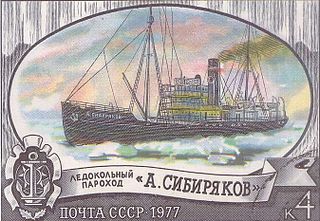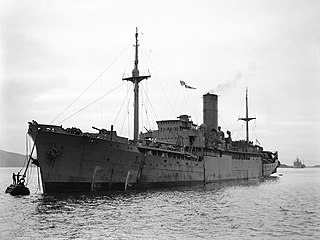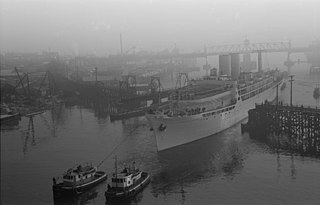
Stella was a passenger ferry in service with the London and South Western Railway (LSWR). She was built in Glasgow in 1890, and wrecked in 1899 off the Casquets during a crossing from Southampton to Guernsey.

Alexander Sibiryakov was a steamship that was built in Scotland in 1909 as Bellaventure, and was originally a seal hunting ship in Newfoundland. In 1917 the Russian government bought her to be an icebreaker. She served the RSFSR and Soviet Union until 1942, when she was sunk by enemy action. The ship gave notable service in the Russian Arctic during the 1930s.

SS Arabic, originally built as Berlin, was a passenger steamship launched on 7 November 1908 which was built by the AG Weser shipbuilding company in Germany. Her gross register tonnage was advertised at 16,786 tons. She made her maiden voyage on 1 May 1909 from New York to Genoa and Bremerhaven. In September 1914 she became an auxiliary cruiser with the Imperial German Navy as a minelayer.

HMS Port Quebec was a British motor ship that was designed and launched in 1939 to be the refrigerated cargo ship Port Quebec, but completed in 1940 as an auxuiliary minelayer. In 1944 she was converted into an aircraft component repair ship and renamed HMS Deer Sound. In 1947 she was returned to her owner, Port Line, and completed as a cargo ship. She was scrapped in Taiwan in 1968.

HMAS Grantala was a passenger steamship that was built in England in 1903 as a coastal interstate liner for the Adelaide Steamship Company. In 1914 the Commonwealth government requisitioned her as a Royal Australian Navy hospital ship.
The Alderney Steam Packet Company provided shipping services between Alderney and Sark, Guernsey and Cherbourg from 1897 to 1931.

This article describes the shipping services of the London and South Western Railway and the vessels employed.

HMS Agamemnon was originally the Blue Funnel Line refrigerated cargo ship Agamemnon. She was built in 1929, traded between the United Kingdom and the Far East, and was scrapped in 1963. During the Second World War she was converted into an auxiliary minelayer in 1940, and then into an amenities ship in 1943.

HMS Menestheus was originally the Blue Funnel Line refrigerated cargo ship Menestheus. She was built in 1929, and traded between the UK and the Far East. She was an auxiliary minelayer from 1940 to 1943. In 1945, during the Second World War, she was converted into an amenities ship. She was scrapped in 1953 after being gutted by fire.

HMS Southern Prince was a motor ship that was built in 1929 as the refrigerated cargo ship Southern Prince. She was commissioned into the Royal Navy in 1940 as a minelayer. She became a headquarters ship and then an accommodation ship in 1944, was a fleet training ship in 1945, and returned to civilian trade in 1946. In 1947 she was sold to Italian owners who had her refitted as a passenger ship and renamed her Anna C. From 1952 she was a cruise ship. She was scrapped in 1972.
HMS Teviot Bank was a Bank Line steamship that was built in England in 1938 as the cargo ship Teviotbank. In the Second World War she was a Royal Navy auxiliary minelayer. By 1956 a Panamanian company had bought her and renamed her Nella. She was scrapped in Italy in 1971.
SS Equity was a freight vessel built for the Co-operative Wholesale Society Limited in 1888.

SS Munich was a North Sea passenger ferry that was built in Scotland in 1908 for the Great Eastern Railway (GER). In the 1923 railway grouping she passed to the new London and North Eastern Railway (LNER). She was scrapped in England in 1950.
SS Northenden was a passenger and cargo vessel built for the Manchester, Sheffield and Lincolnshire Railway in 1886.

SS City of Bradford was a British passenger and cargo steamship that was built in Yorkshire in 1903, renamed Donau in 1916, reverted to City of Bradford in 1919 and became Hanne in 1936.

SS City of Leeds was a British North Sea passenger and cargo steamship that was built in Yorkshire in 1903 and scrapped in Northumberland 1937. In the First World War the Imperial German Navy captured her and used her as a depot ship.
SS Laura was a passenger vessel built for the London and South Western Railway in 1885.

SS Lydia was a passenger ferry that was built in Scotland in 1890 for the London and South Western Railway. From 1920 onward she passed through several owners. In 1923 she was renamed Ierax and registered in Greece. She was scrapped in 1933.
TSS Lorina was a passenger vessel built for the London and South Western Railway in 1918.
Rahmi Kaptan was a ship that was built in 1873 as Honfleur by Aitken & Mansel, Glasgow for the London and South Western Railway. She was sold to Greece in 1911 and renamed Chrysallis then Chrysalis. She was sold to the French Navy in 1917 and served as the patrol vessel Fauvette, later Fauvette I. In 1924, she was sold to Turkey and renamed Ihsanie. She operated for a number of Turkish owners under the names Aidin, Aydin, Cihat, Demirhisar and Rahmi Kaptan, serving until c.2005.













